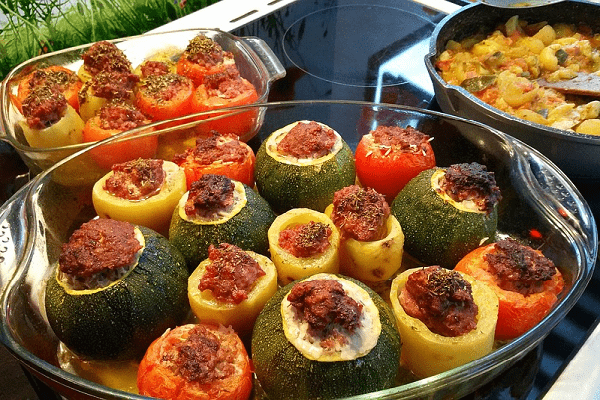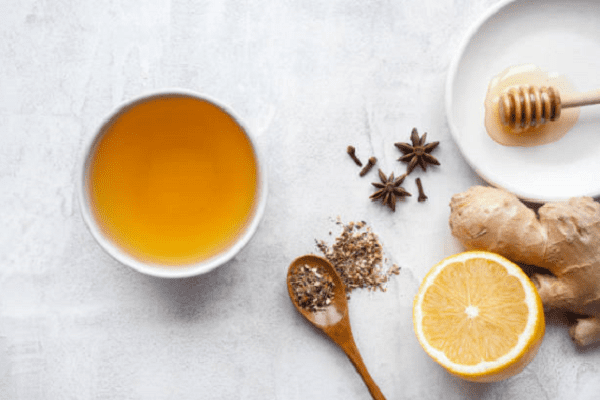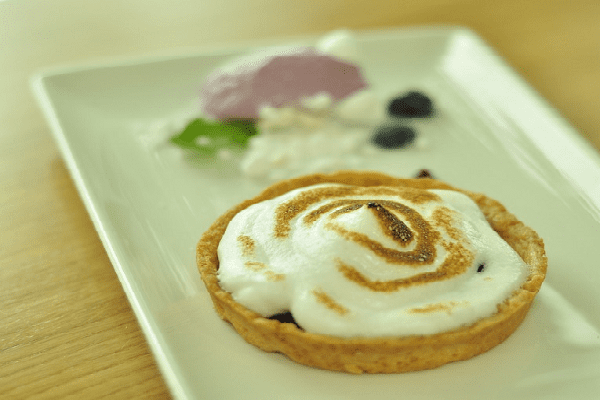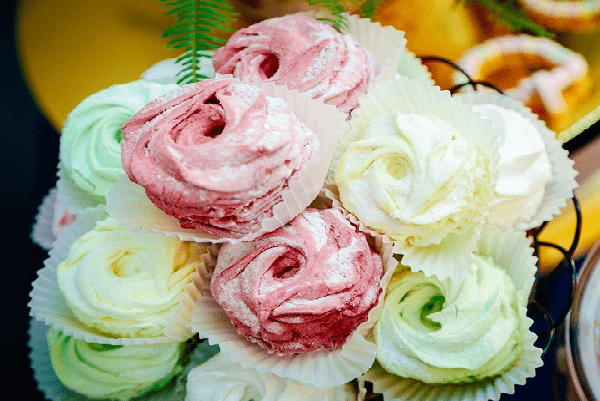Healing diets >>>> Festive diet
Festive diet.

Festive feasts are a challenge for dieters, since it is difficult to stay within the framework of a diet (medical, sports or wellness), when the table is bursting with dishes that do not correspond to the dietary regimen and beckon with their appearance, smell and easy accessibility. Few willpower is able to withstand such a temptation, to resist the principles in order to adequately push the proposed plate of delicious food.
If on holidays you expect to eat tasty food and, as a rule, tasty food in most cases goes "at odds" with dietary food, it is not necessary to "mortify" yourself with boring diet food. This problem is not so difficult to solve if you learn to replace some of the ingredients in holiday dishes with nutritionally useful, but in no way spoiling the overall taste of the dish.
How to hold out on a diet during long holidays and at the same time have a tasty meal? How to relate the usual holiday menu to the festive diet?
If you are struggling with bad cholesterol and excess weight, usually eat low-fat food, then you will not have to deny yourself meat dishes of any degree of fat content, if you do not cook them in a double boiler or boiled, as usual, but on an electric grill or oven grill or on a portable grill (can be placed within a room, balcony or closed veranda, since it does not work on coal, but on electricity).
Our ancestors did not suffer from obesity for two reasons: they moved a lot and ate meat cooked on skewers, where the fat melts and flows down, and pure fat-free meat remains in the food.
The method of cooking meat baked in foil in the oven (boiled pork) also does not go against the diet, it is only necessary to cut off all external fatty places in advance. And then ready-made pieces of boiled pork, you will eat so that inclusions from fat are not sent to your mouth - just cut them off in a plate carefully with a knife and set aside. And in order not to draw the guests' attention to the "preparation" of your piece of boiled pork, do it naturally - cut the selected piece of pork so that the cuts go through the fatty places in advance, and no one will understand anything.
Baked poultry has one drawback for dieters - the fried skin, which is unbearably attractive to eat, but full of fat. There is only one way out - do not eat the skin! This is what hidden willpower is for. But if you yourself prepare poultry dishes for the festive table, then get rid of the skin in advance, and wrap the poultry meat in breading (bread crumbs with mustard or another type of breading) or a coat made of a thin layer of dough, which will brown and serve as a good substitute for fried skin.
A primordially festive dish aspic (or aspic) is usually prepared in meat broth (pork and / or chicken), which is associated with the release of not only gelling substances into the broth, but also fats located on pork or chicken bones and skin. Fatty jellied meat - of course, a tasty dish, but not healthy, from which side you do not consider its composition. So, along with gelling, you get into the broth the full composition of those antibiotics and hormones that were involved in maintaining the health of pigs or poultry (and your personal household is no exception - you do all vaccinations regularly). This property of homemade jellied broth can be bypassed by boiling it from game - wild pig or partridge. But chasing game on the eve of the holidays is not an exciting activity, and fat will still be present to some extent in the broth.
Another way of cooking jellied meat is to cook it not in meat, but in vegetable or fish broth, and then “gel” it with gelatin. For these purposes, pieces of meat (beef, pork, veal, lamb, wild animals) or poultry (game) are boiled in a separate saucepan, which are poured with vegetable broth cooked at the same time (onions, garlic, carrots, cabbage (any types), rutabagas, potatoes , bell peppers, legumes, mushrooms, spices in any combination) or fish (from lean fish), in which gelatin is diluted.
The advantages of such preparation of jellied meat (aspic) is that the cooking time is significantly reduced, since there is no need to cook the bones over low heat, and the meat itself (any) and fish are cooked for about an hour (old and tough meat a little longer). And on top of that, you get a chemically pure broth and ingredients for jellied meat (aspic), defatted in advance.
Festive side dishes are almost always heavy dishes, as they are traditionally prepared on greased baking trays, deep-fried or with the addition of high-calorie ingredients (for example, meat, eggs, potatoes, rice in salads). Side dishes of legumes, mushrooms and fresh cabbage are also unsuccessful when combined with carbonated drinks - not only do they take a long time to digest and cause heaviness in the stomach and intestines, but they can also "poison" the holiday with increased gas production.


To avoid troubles with the gastrointestinal tract at the festive table, you should prepare light side dishes for meat dishes: vegetables baked without fat (carrots, bell peppers, eggplants, zucchini, sweet onions, chicory, fennel or celery cabbage, kohlrabi, broccoli, cauliflower or Brussels sprouts, Jerusalem artichoke), boiled vegetables (asparagus, cauliflower, broccoli, Brussels sprouts, artichoke), seafood (they are low in calories) and cook salads or snacks from the same ingredients.
Spicy dishes and sauces are contraindicated for many dieters. There is an exit! So that onions, bell peppers and other vegetables are not bitter and spicy in a dish and do not irritate the stomach, cut them into the desired shape and scald them in a colander with boiling water (put them in boiling water for half a minute). Cook sauces and marinades on vinegar with honey (replace vinegar with liquid honey or 90% honey solution (10 parts water and 9 parts honey)). Replace hot herbs with basil and rosemary. These herbs, even when scalded (boiled), retain their specific flavor and improve the taste of meat, fish and vegetable dishes.
Mayonnaise, such a favorite ingredient in all holiday salads and dressings, is not acceptable for dietary nutrition. It is well replaced by kefir or soft feta cheese, which does not change the taste of the dish at all, but will make it convenient for dietary nutrition.
And if you are used to baking the dish usually under a layer of mayonnaise, then bake it not under mayonnaise, but under a layer of cheese. The taste will be more refined.
Desserts on the festive table are always a frustration for adherents of any diet, since carbohydrates, no matter how you combine them, are always high in calories. To reduce the calorie content of sweet dishes, you can make them not with an abundance of sweet cream, but with decorations from natural fruits and berries (fresh, canned, dried, dried), nuts and nut powder, honey. Better yet, divide the cream and sweet fillings (jams, preserves, etc.) and flour sweet pastries into two or more desserts. For example, instead of a cake with an abundance of cream (even if the cream is not oil-based), prepare biscuit cakes, diversifying their taste with sprinkles or impregnation and separately cream in the outlet (two dessert dishes).
If for diet purposes, alcohol consumption is limited, then it is not necessary to make the impregnation from liquor, rum or other alcohol-containing liquids - it is enough to cook a honey drink, which will serve as an impregnation for the dough and entertainment for those who do not drink due to illness or life principles.
How to make a honey drink? If there are two weeks before the holiday, then the recipe for the drink will be similar to a low-alcohol beer. To do this, you need a pound of honey, two lemons (juice), 25 gr. hops (sold at the pharmacy), a small ginger root (fresh and about 10 cm long), two and a half liters of water. Boil the water and pour honey over it, stir, let the honey settle and collect the foam or wax that has emerged from the surface of the water (excess ingredients and additives in honey). Next, boil a solution of honey with water, throw the hops into the solution in a linen bag tied to a weighting agent (for example, a stainless steel teaspoon), otherwise the bag will float on the surface, the ginger root cut into slices and simmer, removing the foam. When the foaming is over, remove the boiled honey from the heat, remove the hops, and the ginger circles, let cool, squeeze the juice from two lemons into it, mix thoroughly and pour into a glass container with an airtight screw cap. Refrigerate the cooled broth for two weeks. After two weeks, the honey drink is ready to drink and can be poured into beautiful bottles for display on a festive table or used to impregnate and improve the taste of desserts. Since there will actually be no fermentation process, the strength of the drink will be conditional.
A quick honey drink is made in one day. To do this, you will need half a liter of honey, two and a half liters of boiled water, 1 cinnamon stick, 1 teaspoon of clove buds (culinary), a pinch of nutmeg powder, one teaspoon of allspice peas, zest and juice of one lemon. Put all the ingredients in a saucepan and let it boil, then transfer to low heat, remove the foam if necessary. When foaming has ended, remove from heat and allow to cool. Further, the drink can be consumed both chilled and warm (room temperature or warmed up), as well as used as an impregnation for baking and a filler for non-alcoholic cocktails. The strength of the drink in terms of alcohol content is zero, but due to the spices, a taste similar to low alcohol strength is achieved.
Ice cream and sweet creams are frequent guests on the festive table. Quick ice cream can be made with 35% whipped cream with powdered sugar (to taste) and frozen in a container in four hours. You will get soft ice cream, and in a day you will get a full-fledged ice cream. You can make banana ice cream by peeling and slicing bananas, freezing them in a container in the freezer until they harden, putting them in a blender, whisking until mashed, and freezing them completely for a day.


A sweet cream not made of butter for dessert is prepared as follows - beat in a blender until a creamy consistency of marshmallows (for example, 10 pieces or more). If you take a pink or yellow marshmallow, then the cream will turn out to be the corresponding color. If you add grated or finely broken chocolate to a white marshmallow in a blender, you get a chocolate cream, and if you add nuts to a marshmallow in a blender, you get a nut cream (corresponding to the color of the selected nut). The rest of the marshmallow combinations are the flight of your imagination!
Such a creamy marshmallow can be spread on ready-made cookies or cakes, laid out with fruit or jam (jam). In the refrigerator or freezer, the marshmallow cream begins to solidify, and in a warm room, on the contrary, softens. These properties of marshmallows can be manipulated for your pastry ideas.

Read

Read



























